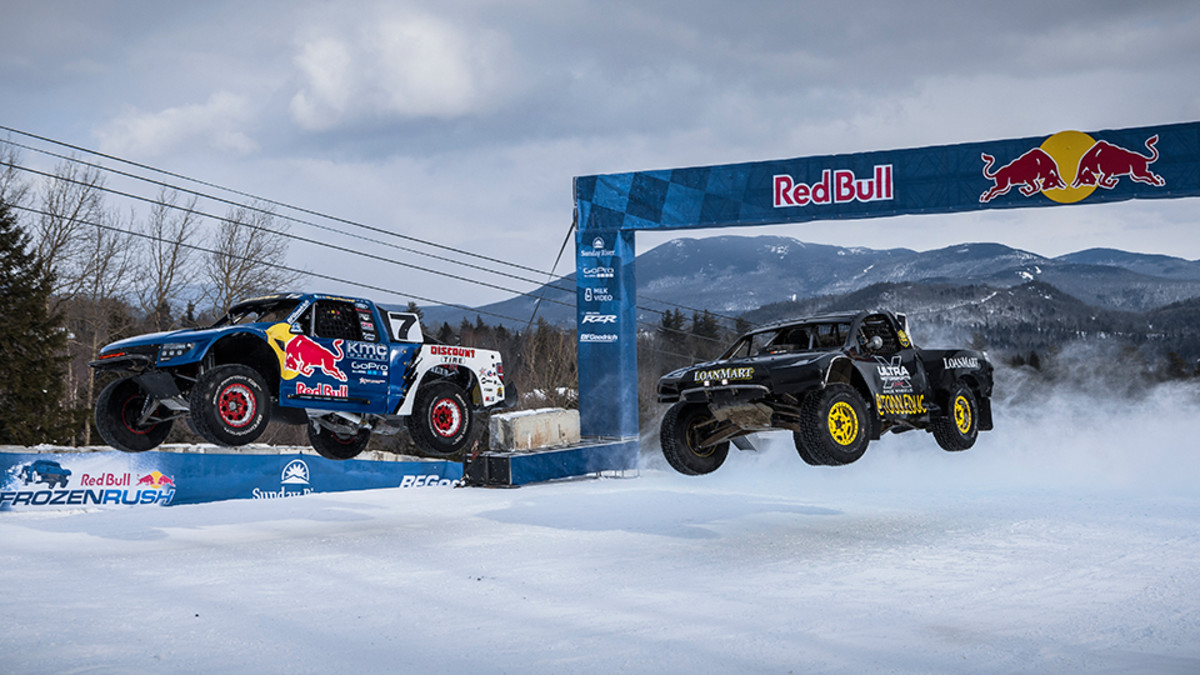
Red Bull Frozen Rush: Do you want to build a snow-track?
There's precious little in life that’s more fun than playing in the snow. Especially with trucks. Racing trucks, mind you.
The second-ever Red Bull Frozen Rush event will be churning up the snow starting Thursday at Sunday River Ski Resort in Maine, but the course offers more than just trucks scattering powder.
The .75-mile course pits two drivers head-to-head with two very distinct lanes, offers uphill and downhill sections in a loop and adds in six gates and 12 total jumps. The inclusion of obstacles keeps the Frozen Rush both under control and fun to watch.
“The purpose of the obstacles is multi-fold,” Jason Smith, race director, tells Edge. “They are used to enhance the entertainment, control the speed and create close competition.”
A heavier dose of gates and jumps appears on the downhill portion of the course to more closely control speed there.
Skiing the World: Exploring the diversity of Utah's mountain ranges
The counter-clockwise track features two gap jumps, one uphill and one downhill. Each gap jump is 10 feet high, with a 40-foot gap for the uphill offering and a 60-foot gap downhill. Two step up jumps feature steeper pitches to the ramp so the truck can jump up to a higher landing. Three step down jumps have a flat take off ramp allowing trucks to jump down the hill. A finish line jump measures five feet high.
The choice of where to place each obstacle is based on the need for speed control and a desire to up the entertainment factor. Which obstacle gets dropped in? The mountain has a little say in that too.
“The decision for which obstacle [being placed where] is determined by space available, terrain—if it’s flat, sloping, uphill, downhill—and position to the onsite spectator,” Smith says. “The width of the course is mostly dictated by the space available and allowing each lane sufficient space.”
The course hasn’t undergone a major overhaul since last year, the first Red Bull Frozen Rush. “We had a really good track last year and going into this year had a lot of notes to go from to design,” Smith says.
But the planners did need to do a better job accounting for all that snow getting kicked up. With a head-to-head race, the snow dusting made it difficult for the driver in a truck slightly behind to see. Along with requiring trucks this year to have a mudflap—call it a snowflap—running the length of the truck, the course now features even more asymmetrical lanes. While each truck runs the same number of laps in each lane, they stay in the lanes longer this year.
On the Road: Let the locals lead, says mountain biker Jerome Clementz
With excess snow kept to a minimum, both for the drivers and spectators, participants will have a better view of the obstacles that can make or break a run. Smith says a standing start adds in the pressure of a five-second penalty for jumping the gun—which could easily be enough to cost a driver the race. But if both trucks start the race without a penalty, every gate and jump has the possibility of proving the difference.
If a driver attacks a gate too fast, they can hit a wall and cost themselves time. Of course, hitting a jump too fast will “upset the trucks and the handling will be hard to get back and recover quickly.”
These drivers may have fun playing in the snow, but they’ll do it with speed in mind.
Red Bull Frozen Rush will be streamed live Friday, Jan. 9 at 12:30 p.m. EST on redbull.com/frozenrush.
Tim Newcomb covers stadiums, design and gear for Sports Illustrated. Follow him on Twitter at @tdnewcomb.




